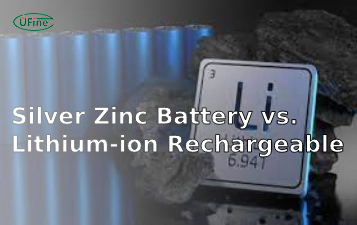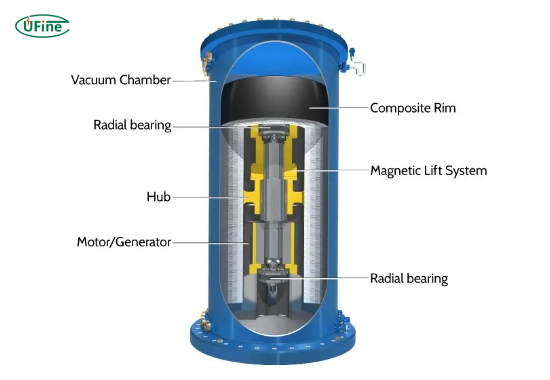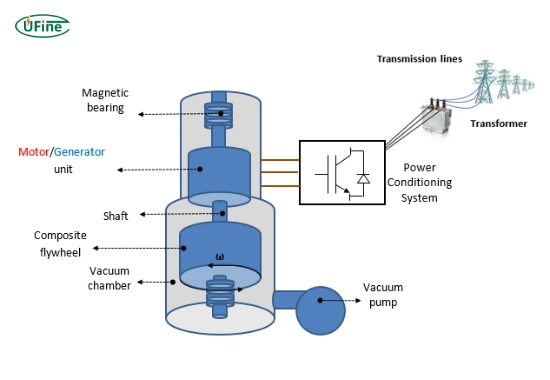
- Part 1. What is a mechanical battery?
- Part 2. How do mechanical batteries work?
- Part 3. Benefits of mechanical batteries
- Part 4. Challenges facing mechanical batteries
- Part 5. Mechanical batteries vs. chemical batteries: A comparison
- Part 6. Applications of mechanical batteries
- Part 7. The future of mechanical batteries
- Part 8. FAQs
As we move towards a more sustainable future, energy storage solutions are becoming increasingly essential. One innovative concept gaining traction is the mechanical battery. But what exactly is a mechanical battery, and how does it differ from traditional energy storage systems? In this article, we will delve into the mechanics of mechanical batteries, their advantages, challenges, and their potential role in the future of energy storage.
Part 1. What is a mechanical battery?
A mechanical battery is an energy storage system that utilizes mechanical components to store and release energy. Unlike chemical batteries, which rely on chemical reactions to generate electricity, mechanical batteries store energy in physical forms, such as potential or kinetic energy. You can achieve this through various methods, including:
- Pumped hydro storage: Water is pumped to a higher elevation, storing gravitational potential energy, which can be released when the water flows back down.
- Flywheels: A rotating mass stores energy. As the flywheel spins, it stores kinetic energy, which the system can convert to electricity.
- Compressed air energy storage (CAES): Air is compressed and stored in underground caverns. When energy is needed, the compressed air is released, driving a turbine to generate electricity.
Part 2. How do mechanical batteries work?
Mechanical batteries operate on the principle of storing energy in a physical form. Here’s a brief overview of how some common types function:
Pumped Hydro Storage
In pumped hydro storage, the system uses electricity to pump water to a higher elevation during periods of low demand. When demand increases, the stored water is released, flowing through turbines to generate electricity. This method is highly efficient and can provide large-scale energy storage.
Flywheels
Flywheels store energy by spinning at high speeds. The system converts the flywheel’s rotational energy back to electricity when needed. Flywheels can respond quickly to changes in demand, making them ideal for balancing supply and demand in real time.
Compressed Air Energy Storage (CAES)
Air is compressed and stored in underground caverns or large containers in CAES systems. The compressed air is heated and expanded when energy is needed, driving a turbine to generate electricity. This method can provide large-scale energy storage but requires specific geological conditions.
Part 3. Benefits of mechanical batteries
Mechanical batteries offer several advantages over traditional chemical batteries:
1. Durability and Longevity
Mechanical batteries generally have longer lifespans compared to chemical batteries. They are less prone to degradation over time, which results in lower replacement costs and reduced environmental impact.
2. Efficiency
Many mechanical battery systems, particularly pumped hydro storage, boast high-efficiency rates, often exceeding 80%. This means that you can recover a significant portion of the stored energy.
3. Scalability
Mechanical batteries can be scaled up or down to meet specific energy storage needs, making them suitable for small and large applications.
4. Environmentally Friendly
Mechanical batteries are considered more environmentally friendly because they do not rely on toxic chemicals. Their components are often made from readily available materials, contributing to sustainability.
Part 4. Challenges facing mechanical batteries
Despite their advantages, mechanical batteries also face several challenges:
1. High Initial Costs
The initial investment for mechanical battery systems, particularly large-scale projects like pumped hydro storage, can be significant. This can deter potential investors and developers.
2. Site-Specific Limitations
Certain mechanical battery systems require specific geographical conditions. For example, pumped hydro storage needs access to large bodies of water and suitable elevation differences, which may not be available everywhere.
3. Energy Density
Mechanical batteries typically have lower energy density compared to chemical batteries. This means they require more space to store the same amount of energy, which can be a limiting factor in urban areas.
Part 5. Mechanical batteries vs. chemical batteries: A comparison
When comparing mechanical and chemical batteries, several key differences emerge:
Energy Storage Mechanism
- Mechanical Batteries: Store energy in physical forms (potential or kinetic).
- Chemical Batteries: Store energy through chemical reactions.
Lifespan and Maintenance
- Mechanical Batteries: Longer lifespan, less maintenance.
- Chemical Batteries: Shorter lifespan, may require more frequent maintenance.
Environmental Impact
- Mechanical Batteries: Generally more environmentally friendly, using fewer toxic materials.
- Chemical Batteries: These can contain harmful chemicals and require careful disposal.
What are Lithium Polymer Batteries?What is a LiFePO4 Battery?
Part 6. Applications of mechanical batteries
Mechanical batteries have a wide range of applications across various sectors:
1. Renewable Energy Integration
Mechanical batteries are crucial in integrating renewable energy sources, such as wind and solar power, into the grid. By storing excess energy generated during peak production times, they help balance supply and demand.
2. Grid Stability
Mechanical batteries, particularly flywheels, are used for grid stabilization. They can provide quick bursts of energy to counteract fluctuations in supply and demand, ensuring a stable electricity supply.
3. Electric Vehicles
While chemical batteries dominate the electric vehicle market, mechanical batteries could offer innovative solutions for energy recovery and efficiency in braking systems.
Part 7. The future of mechanical batteries
The future of mechanical batteries looks promising as ongoing research and technological advancements continue to improve their efficiency and reduce costs. Innovations in materials science and engineering could lead to new types of mechanical batteries that are even more efficient and versatile.
1. Hybrid Systems
Combining mechanical and chemical batteries could create hybrid systems that leverage both technologies’ strengths, leading to more efficient and flexible energy storage solutions.
2. Urban Applications
The need for compact and efficient energy storage solutions will increase as urban areas grow. Existing infrastructure may integrate mechanical batteries, which have become essential.
3. Sustainability Initiatives
With a growing focus on sustainability, mechanical batteries present a viable alternative for energy storage that aligns with environmental goals. Their lower environmental impact makes them attractive for future energy systems.
Part 8. FAQs
-
What are the main types of mechanical batteries?
Mechanical batteries primarily include pumped hydro storage, flywheels, and compressed air energy storage (CAES), each utilizing different methods to store and release energy. -
Are mechanical batteries efficient?
Yes, mechanical batteries can be highly efficient, with systems like pumped hydro storage achieving efficiency rates above 80%. -
How long do mechanical batteries last?
Mechanical batteries generally have a longer lifespan than chemical batteries, often lasting several decades with proper maintenance. -
Are mechanical batteries environmentally friendly?
Yes, people consider mechanical batteries more environmentally friendly than chemical batteries because they do not rely on toxic materials and have a lower environmental impact. -
Can mechanical batteries be used for electric vehicles?
While electric vehicles primarily use chemical batteries, mechanical batteries may offer innovative solutions for energy recovery and improve overall efficiency.
Related Tags:
More Articles

What is the Difference Between Silver Zinc Battery vs. Lithium-ion Rechargeable?
Compare silver zinc and lithium-ion rechargeable batteries: energy density, cycle life, safety, cost, and uses in drones, medical devices, EVs, and electronics.
What are Watts and Watt Hours in Battery?
Understand watt vs watt-hour in batteries: key differences, how to calculate capacity, and why they matter. Includes free comparison table.
Best 10 Blood Pressure Monitor Battery Review: Finding the Most Reliable
Are you looking for a reliable Blood Pressure Monitor battery? Here is a complete guide with the top 10 best blood pressure monitor batteries.
Bluetooth Headphone Battery Guide: All You Need to Know
Maximize headphone battery life with expert tips! Learn how to charge, check, troubleshoot, and choose the best bluetooth headphone battery in 2025.
LiFePO4 Battery VS. Lithium-ion Polymer Battery: Which One Is Best?
Comprehensive comparison of LiFePO4 vs Lithium Ion Polymer batteries: energy density, safety, lifespan, cost. Find out which battery suits your needs in 2025.




